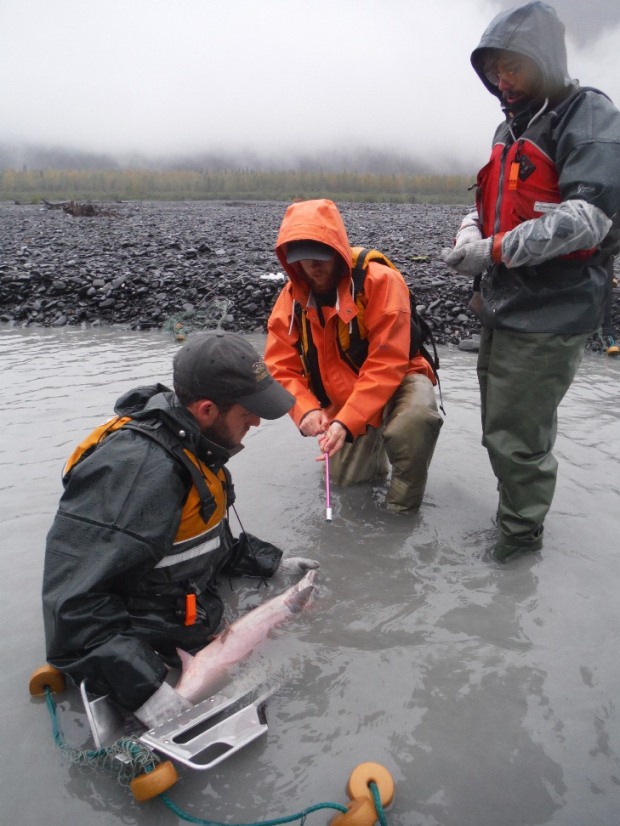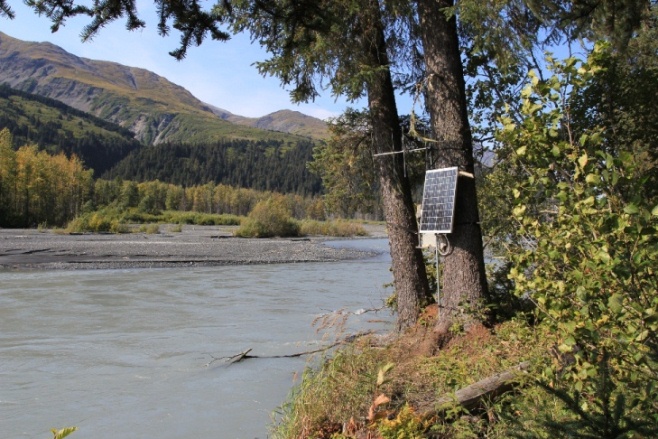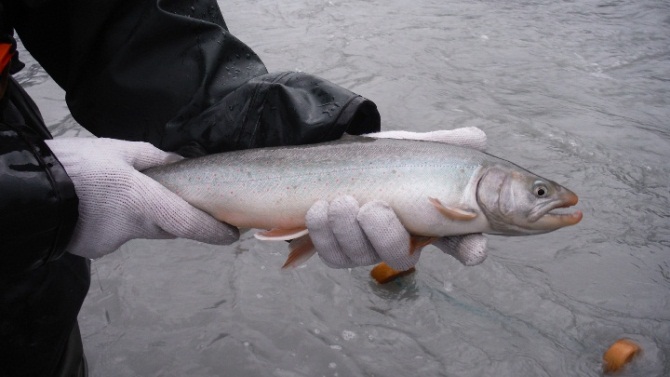
Lake Clark National Park biological technicians tagging Coho with radio transmitter.
Photo NPS / Laura Phillips
One of the most interesting things that we do is radio tagging coho salmon, and tracking them as they migrate upstream. The tags give off a radio pulse with a unique identifier. Using special receivers, we can pick up these signals and figure out the location of each fish. We have three stations set up along the length of the river that record whenever a fish passes by. Flights in an airplane equipped with a receiver also help locate the areas where the salmon have traveled. Finally, we hike into the backcountry with a portable receiver to find the tributaries and backwaters where the fish might spawn.
Catching salmon is a new and exciting challenge each day. We catch the fish in the lower portion of the river where many braided channels can be seen flowing on a broad gravel riverbed. This portion of the river is the most dynamic because it has large amounts of glacial input. Glaciers, including the well-known Exit Glacier, also contribute large quantities of gravel and fine rock particles that make the water a milky grey that is impossible to see through. Water levels and channel courses vary by the minute especially after the frequent rains that are common to the region.

Telemetry tower automatically records fish with transmitters as they get in range.
Photo: NPS
We go fishing every other day to capture coho salmon for tagging. Driving rain and bone-chilling water can make the work difficult, but each time out is a new adventure. We carry our sampling gear including a 50 foot long net on our backs using a pack frame and hike to our sampling sites. We wear chest waders and wade across the swift channels while searching for places with water calm enough to set the net. These areas are usually where old channels meet the main channel to form a small slough. After we find a suitable slough, we stretch the net along the eddy line (the interface between flowing and calm water). After the opening to the small bay is closed off by the net we scare the fish toward it. Once we feel fish start to hit the net, we quickly purse it to the shore to encircle and trap them.
Salmon tagging is an exciting process! As quickly as possible, we untangle the salmon from the net and identify the species and sex. Next we place the coho into a cradle that is equipped with a measuring board to take a length measurement and remove a genetic sample from a small non-essential fin. Finally we insert a radio tag through the salmon's mouth and into its stomach. The fish is then immediately released unharmed to swim upstream and complete its life cycle.
It is too soon to tell what the results will of our project will reveal but it has been exciting to find that salmon and Dolly Varden char are abundant in the river. When we began in late August we did not know what to expect from the cloudy waters. At first we caught sockeye, Dolly Varden, and even a couple of Chinook salmon but it wasn't long before we began to catch coho. Now we are regularly catching and tagging coho and tracking them upstream. Soon we will learn the final destinations of the fish that we have tagged, so stay tuned for future updates!

Dolly Varden are frequently caught in the net as well as Coho.
Photo: NPS
